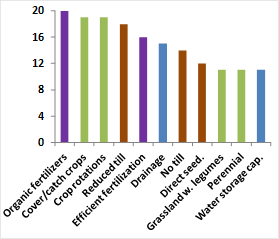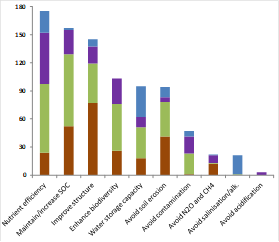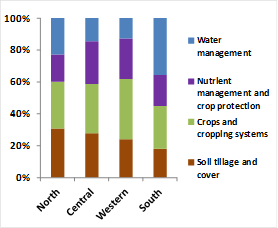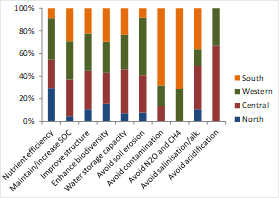INTRODUCTION
The awareness about the vital role of soil for nature and society has been increasing and soil is presently a priority of research, development and innovation programs in Europe. Research on agricultural soils and soil sustainable management practices has a long history and there is large body of knowledge available. On the other hand, the current rate of soil degradation, at a faster speed than its production (Panagos et al., 2015), shows that there is a need for research and/or dissemination of sustainable soil management practices. Furthermore, there are emerging challenges for the management of agricultural soils, such as the decrease of greenhouse gas emissions. In order to design effective research strategies, there is the need to identify the current knowledge level and knowledge gaps related to the sustainable management of agricultural soil.
According to (FAO, 2017) “Soil management is sustainable if the supporting, provisioning, regulating, and cultural services provided by soil are maintained or enhanced without significantly impairing either the soil functions that enable those services or biodiversity”. The scope of this study are the practices which have evidenced impacts (positive, negative or neutral), either in scientific literature or other knowledge sources. The study collected systematic information from twenty three European countries about the impacts of sustainable agricultural soil management practices (SSP). The results can be used to describe the current state and the knowledge gaps in agricultural soil management in Europe.
MATERIAL AND METHODS
The research teams participating in the European Soil Programme Soil (EJPSOIL) compiled information by consulting scientific information, knowledge repositories, and stakeholders, according to their specific contexts. The compiled information was used to complete a questionnaire on the impacts of SSP. The questionnaire included a total of 30 predefined SSP, grouped in four management groups:
Soil tillage and cover
Crop and cropping system
Nutrient management and crop protection
Water management
For each SSP, the teams were asked to add information relatively to the specific context of application (such as the level of deployment), to identify up to three impacts and to describe them in a quantitative manner, whenever possible, and to list up to three references. The impacts could be described as positive, negative, or neutral, which can be used to describe trade-offs between impacts for a given SSP. Each impact was related to a soil challenge, according to the predefined EJPSoil soil challenges (Keesstra et al., 2021):
Maintain/increase soil organic carbon (SOC)
Avoid N2O and CH4 emissions from soils
Avoid soil erosion
Avoid salinisation and alkalinisation
Avoid acidification
Avoid contamination
Improve soil structure
Enhance soil biodiversity
Enhance soil nutrient use efficiency
Enhance water storage capacity
The reported knowledge on SSP and their impacts may acquire varying significance according to the pedo-climatic and geographical contexts. In order to analyse the geographical context, the results were analysed according to European regions (ER), defined as following:
Northern Europe (Denmark, Norway, Sweden, and Finland)
Central Europe (Austria, Czech Republic, Estonia, Germany, Hungary, Slovakia, Slovenia, Poland, Lithuania, Latvia, and Switzerland)
Western Europe (Belgium, France, Netherlands, and United Kingdom)
Southern Europe (Portugal, Spain, Italy, and Turkey).
RESULTS
Overview of most reported SSP
Figure 1 shows the most reported SSP (> 10 reports), accounting SSP only once per each country. The three most reported SSP were “Organic fertilizers”, “Catch/cover crops”, and “Crop rotations”. The most reported SSP include practises from each of the four management groups (legend of management groups in Figure 2).

Figure 1 Ranking of the most reported SSP. The filling of the colours indicates the management group of each SSP (see legend in Figure 2).
SSP management groups per European Region
Figure 2 shows the distribution of knowledge about the impacts of SSP among the different ER. The number of reports is expressed in percentage because ER are composed by different number of countries, resulting in a bias when analysing the absolute value of reports. Figure 2 shows that SSP from all management groups are well represented within the different ER. But, it is possible to identify relatively different levels of knowledge between ER: in Northern Europe, the main group was “Soil tillage and cover”, in Central Europe, the main group was “Crop and cropping systems”, in Western Europe it was “Crop and Cropping systems”, and in Southern Region, it was “Water management”, which is likely related to differences in regional concerns over soil management and soil challenges.
Soil challenges and SSP
Figure 3 shows the total number of reports for each soil challenge and the management group of the related SSP (see legend in Figure 2). The three challenges with most reported knowledge are “Enhance soil nutrient use efficiency”, “Maintain/Increase soil SOC”, and “Improve soils structure”.
Considering “Enhance soil nutrient use efficiency”, the most reported SSP are related to cropping system (mainly “Crop rotations”, “Cover/catch crops”, and “Grasslands”) and to nutrient management (mainly “Organic fertilizers”, “Efficient fertilization”, and “Biofertilizers”). Even if many reports lack quantitative information, there is evidence of a good body of knowledge related to the positive impacts of these SSP.
Relatively to “Maintain/Increase soil SOC”, the most reported SSP are those related to cropping system (mainly “Crop rotations”, “Cover/catch crops”, and “Perennials”), those that reduce soil mobilization (“No till”, “Reduced till”), and those related to the “Organic fertilizers”. Several studies report quantitative results on the increase of SOC as a result of these SSP, but these are mainly for the topsoil. Few reports indicate that no significant differences in SOC were found in deeper layers, or even that it decreases with depth. These results indicate that further knowledge is needed on what extend these SSP impact SOC.
The three soil challenges with less reported knowledge are “Avoid N2O and CH4 emissions from soils”, “Avoid salinisation and alkalinisation”, and “Avoid acidification”. The last two challenges are likely to have comparatively low reported knowledge due to the regional relevance of these challenges. On the other hand, “Avoid N2O and CH4 emissions from soils” would be expected to be of overall concern. There was a low amount of reported studies about emissions of N2O and CH4 from agricultural soils which points out to the need for further research and dissemination of SSP contributing to reducing emissions from soils.

Figure 3 Number of reported SSP related to each soil challenge, grouped by management groups (see legend of management groups in Figure 2).
Soil challenges per European Region
Figure 4 shows the distribution of knowledge about the soil challenges among the different ER. The figure shows that some challenges are not reported in some ER such as “Avoid contamination” and “Avoid N2O and CH4 emissions” which are not reported in Northern Europe. “Avoid salinisation and alkalinisation” is only reported in Western and Southern Europe, which can result from regional concerns associated with irrigation management practices and climate conditions. “Avoid acidification” is only reported in Central and Western Europe which points out to concerns over acidification effects in these regions.
CONCLUSIONS
The consultation to the 23 European research teams indicated that knowledge is rather well spread over SSP in the four management groups, both at a general and regional level. When considering the evidences of the impacts of the SSP, some conclusions can be made, such as the need for further knowledge on the impacts of SSP on improving SOC ad deeper layers. There is also a high variability in the level of knowledge or awareness about the SSP related to the different soil challenges. The need for further knowledge on practices to decrease greenhouse gas emissions from agricultural soils could be clearly identified.
















